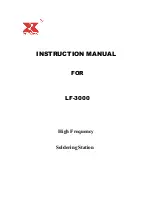
858D
SMD REWORK STATION User Manual
Welcome to use 858D rework station. This manual will show the parameters, performance, usage
and precautions of this machine.
If you have any problem of usage or any suggestion about this soldering station, please send the
email to
thank you.
Warranty
1: if hot air gun was broken within a year, we will send a replacement to you after connecting with
After-sales service mailbox.
2:If the gadgets in the package are lost during the shipping, please contact us for re-send.
3:We will guide you carefully about the use and maintenance of this product.
858D rework station is good for repair phone and PCB circuit board. Please read this operating
instruction manual carefully before using the serial soldering station of our company.
If you like our product, can you share your experience or review for it on Amazon. It can help us a
lot,thanks in advance.
Specification
Model
NEW858D
Type
LED indicator light
Power
Consumption
700W
Blower Fan
Brush-less Fan
Amount Of Wind
120L/m(MAX)
Temperature Range 100
℃
-500
℃
Discharge Feature
LED indicator light
Handle Length
(With Cable)
120cm
Size
12.4(h)*18.7(w)*
24.9(l)(cm)
13.8(h)*10(w)*15(l)(cm)
Weight
2.20kg
1.52kg
1.55kg
Noises
<45db
Usage
Hot-air rework stations can be very handy. As mentioned above, they are a crucial tool when it comes to
reworking a board. The term rework just means you are refinishing or repairing an already reflowed board,
and it is a term commonly used in the electronics world. Just think of it as doing any work to the board
that wasn't involved in the actual production process. Here are some common rework scenarios:
Polarized Components
- Parts that have been placed incorrectly (backwards, shifted x degrees off). These
include ICs, diodes, some capacitors, connectors, etc.
Tombstone Parts
- This is when a part (usually a resistor or capacitor) reflows only on one side. The part
usually sticks strait up resembling a tombstone.
Cold Joints
- This is similar to a tombstone except the parts might not be sticking strait up, making it
harder to see the connection that is not being made.
Removing Defective Parts
- Sometimes, during the IC manufacturing process, errors can arise and go
unnoticed. These ICs are then placed on perfectly good PCBs. Hot-air is great for replacing these bad parts.
Missing Components
- The smaller the component, the easier it is for it to disappear. This can happen
before or during reflow, resulting in a spot where something should be, but isn't. Hot-airing a new part in

















